
The hardware and bandwidth for this mirror is donated by METANET, the Webhosting and Full Service-Cloud Provider.
If you wish to report a bug, or if you are interested in having us mirror your free-software or open-source project, please feel free to contact us at mirror[@]metanet.ch.

SemanticDistance does the following operations: - cleans
and formats ordered text (monologues and dialogues) - cleans and formats
unordered word lists (e.g., bags-of-words) - computes pairwise semantic
distance metrics using numerous chunking options - finds clustering
solutions and creates simple semantic networks from given word list
vectors.
Install the development version of SemanticDistance
using the devtools package.
#devtools::install_github("Reilly-ConceptsCognitionLab/SemanticDistance")
library(SemanticDistance)SemanticDistance contains specialized functions for
processing the text formats delineated to follow. To learn more about
the specific options for string cleaning, computing distances, and
visualizing output for each of these formats, visit its corresponding
vigbnette.
| mytext |
|---|
| The girl walked down the street. The wrestler punched the boxer. I could not open the door. 95 dogs jumped on me. |
A monologue for our pourposes consists of any block of text NOT
delineated by a talker/speaker. This includes ordered texts like stories
or narratives, or unordered lists (i.e., bags of words). The minimum
requirement for a monologue is one row and one column with some text in
it. Here’s a sample monologue.
| text | speaker |
|---|---|
| Hi Peter. It’s nice to see you | Mary |
| Hi Mary. Hot out today | Peter |
| It sure is. | Mary |
| Did you read that book? | Peter |
| No I haven’t had time. | Mary |
A dialogue is an ordered language sample split by a
talker/speaker/interlocutor factor. The minimum requirement for
formatting dialogues is to supply a dataframe with two columns. One
column is delineated by a speaker_id (e.g., name, speaker, talker) and
the second column should contain the speaker’s corresponding text
output. Above you will see a sample dialogue formatted correctly for all
proceeding steps of SemanticDistance.
| word1 | word2 |
|---|---|
| Dog | trumpet |
| the | BANANA |
| rat | astronaut |
| *&^% | lizard |
| bird | bird |
| shark | shark |
Word pairs arrayed as vectors within columns. The minimum requirment
is two columns with at least one row of paired data (e.g., dog, leash).
Here’s a sample dataframe of word pairs formatted correctly for all
proceeding steps of SemanticDistance.
| mytext |
|---|
| trumpet trombone flute piano guitar gun knife missile bullet spear apple banana tomato sad angry happy disgusted |
An unordered bag of words. You needn’t split your text but okay if you do. Here’s a sample dataframe. You would use this format for analyzing structure and network properties using dendrogram or network options.
Transforms text to lowercase then optionally clean (omit stopwords, omit non-alphabetic chars), lemmatize (transforms morphological derivatives of words to their standard dictionary entries), and split multiword utterances into a one-word-per row format.
clean_monologue_or_listArguments to
clean_monologue_or_list
-dat raw
dataframe with at least one column of text.
-wordcol
quoted variable column name where your target text lives (e.g.,
‘mytext’)
-omit_stops omits stopwords, T/F default is
TRUE.
-lemmatize transforms raw word to lemmatized
form, T/F default is TRUE.
Monologue_Cleaned <- clean_monologue_or_list(dat=Monologue_Typical, wordcol='mytext', omit_stops=TRUE, lemmatize=TRUE)
knitr::kable(head(Monologue_Cleaned, 12), format = "pipe", digits=2)| id_row_orig | text_initialsplit | word_clean | id_row_postsplit |
|---|---|---|---|
| 1 | the | NA | 1 |
| 1 | girl | girl | 2 |
| 1 | walked | walk | 3 |
| 1 | down | down | 4 |
| 1 | the | NA | 5 |
| 1 | street. | street | 6 |
| 1 | the | NA | 7 |
| 1 | wrestler | wrestler | 8 |
| 1 | punched | punch | 9 |
| 1 | the | NA | 10 |
| 1 | boxer. | boxer | 11 |
| 1 | i | NA | 12 |
clean_dialogueArguments to
clean_dialogue
-dat your raw
dataframe with at least one column of text AND a talker column.
-wordcol column name (quoted) containing the text you want
cleaned.
-whotalks column name (quoted) containing the
talker ID (will convert to factor).
-omit_stops omits
stopwords, T/F default is TRUE.
-lemmatize transforms
raw word to lemmatized form, T/F default is TRUE.
Dialogue_Cleaned <- clean_dialogue(dat=Dialogue_Typical, wordcol="text", who_talking = "speaker", omit_stops=TRUE, lemmatize=TRUE)
knitr::kable(head(Dialogue_Cleaned, 12), format = "pipe", digits=2)| id_row_orig | text_initialsplit | speaker | word_clean | id_row_postsplit | turn_count |
|---|---|---|---|---|---|
| 1 | hi | Mary | NA | 1 | 1 |
| 1 | peter | Mary | peter | 2 | 1 |
| 1 | its | Mary | NA | 3 | 1 |
| 1 | its | Mary | NA | 4 | 1 |
| 1 | nice | Mary | nice | 5 | 1 |
| 1 | to | Mary | NA | 6 | 1 |
| 1 | see | Mary | see | 7 | 1 |
| 1 | you | Mary | NA | 8 | 1 |
| 2 | hi | Peter | NA | 9 | 2 |
| 2 | mary | Peter | mary | 10 | 2 |
| 2 | hot | Peter | hot | 11 | 2 |
| 2 | out | Peter | out | 12 | 2 |
clean_paired_colsYour data for computing pairwise semantic distance are arrayed in two
paired columns in a dataframe. These columns need not be adjacent. You
will specify their variable names in the function call.
Arguments to
clean_paired_cols
-dat your raw
dataframe with two columns of paired text.
-word1
quoted variable reflecting the column name where your first word lives.
-word2 quoted variable reflecting the column name
where your first word lives.
-lemmatize transforms raw
word to lemmatized form, T/F default is TRUE.
WordPairs_Clean <- clean_paired_cols(dat=Word_Pairs, wordcol1='word1', wordcol2='word2', lemmatize=TRUE)
knitr::kable(head(WordPairs_Clean, 6), format = "simple", digits=2) | id_row_orig | word1_clean | word2_clean | word1 | word2 |
|---|---|---|---|---|
| 1 | dog | trumpet | Dog | trumpet |
| 2 | the | banana | the | BANANA |
| 3 | rat | astronaut | rat | astronaut |
| 5 | bird | bird | bird | bird |
| 6 | shark | shark | shark | shark |
| 8 | dog | leash | Dog | leash |
Now compute semantic distance for your selected format from one of
the options below.
dist_ngram2wordThis function works on monologues (continuous ordered samples) only!
Computes cosine distance using a rolling ngram approach consisting of
groups of words (ngrams) to the next word. IMPORTANT the
function looks backward from the target word skipping over NAs until
filling the desired ngram size.
Arguments to
dist_ngram2word:
-dat dataframe of
a monologue transcript cleaned and prepped.
-ngram
window size preceding each new content word.
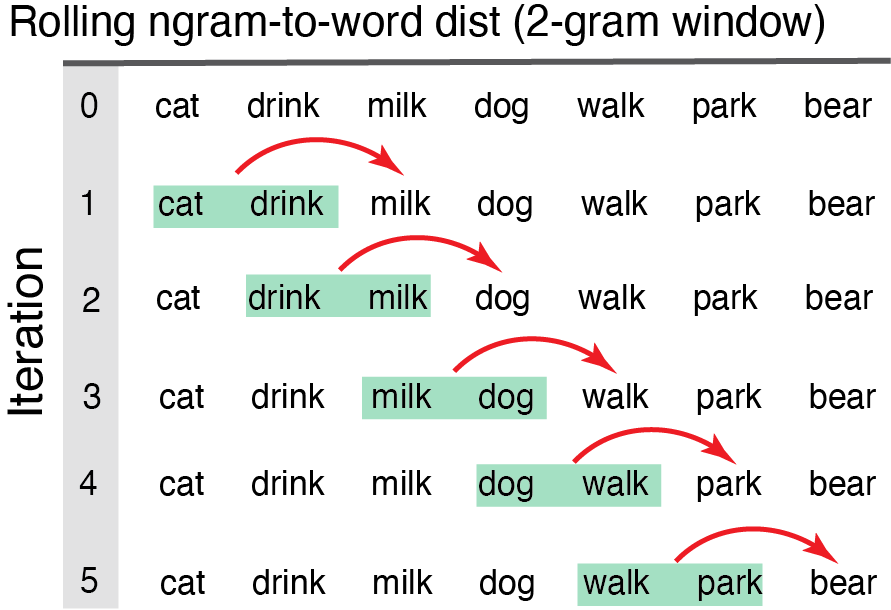
Ngram2Word_Dists1 <- dist_ngram2word(dat=Monologue_Cleaned, ngram=1) #distance word-to-word
knitr::kable(head(Ngram2Word_Dists1, 8), format = "pipe", digits = 2)| id_row_orig | text_initialsplit | word_clean | id_row_postsplit | CosDist_1gram_glo | CosDist_1gram_sd15 |
|---|---|---|---|---|---|
| 1 | the | NA | 1 | NA | NA |
| 1 | girl | girl | 2 | NA | NA |
| 1 | walked | walk | 3 | 0.47 | 1.06 |
| 1 | down | down | 4 | 0.28 | 0.80 |
| 1 | the | NA | 5 | NA | NA |
| 1 | street. | street | 6 | 0.36 | 0.87 |
| 1 | the | NA | 7 | NA | NA |
| 1 | wrestler | wrestler | 8 | 0.97 | 0.63 |
dist_ngram2ngramThis function works on monologues (continuous ordered samples) only.
User specifies n-gram size (e.g., ngram=2). Distance computed from each
two-word chunk to the next iterating all the way down the dataframe
until there are no more words to ‘fill out’ the last ngram.
Arguments to
dist_ngram2ngram
-dat dataframe w/
a monologue sample cleaned and prepped
-ngram chunk
size (chunk-to-chunk), (e.g., ngram=2 means chunks of 2 words compared
to the next chunk of two words).
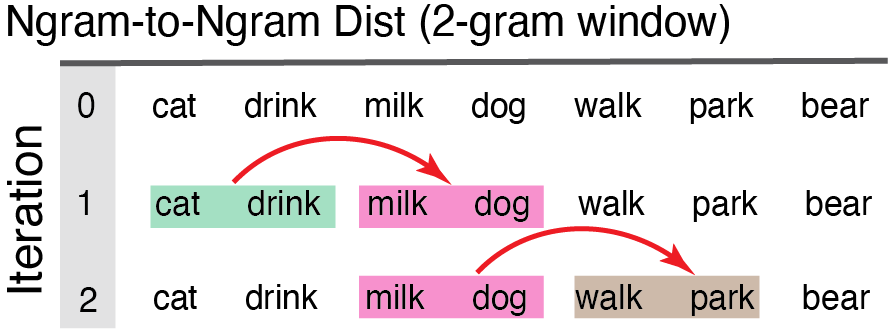
Ngram2Ngram_Dist1 <- dist_ngram2ngram(dat=Monologue_Cleaned, ngram=2)
knitr::kable(head(Ngram2Ngram_Dist1, 8), format = "pipe", digits = 2)| id_row_orig | text_initialsplit | word_clean | id_row_postsplit | CosDist_2gram_GLO | CosDist_2gram_SD15 |
|---|---|---|---|---|---|
| 1 | the | NA | 1 | NA | NA |
| 1 | girl | girl | 2 | NA | NA |
| 1 | walked | walk | 3 | NA | NA |
| 1 | down | down | 4 | 0.14 | 1.05 |
| 1 | the | NA | 5 | 0.06 | 0.09 |
| 1 | street. | street | 6 | 0.32 | 0.94 |
| 1 | the | NA | 7 | 0.32 | 0.94 |
| 1 | wrestler | wrestler | 8 | 0.93 | 1.18 |
dist_anchorThis function works on monologues (continuous ordered samples) only!
Models semantic distance from each successive new word to the average of
the semantic vectors for the first block of N content words. This
anchored distance provides a metric of overall semantic drift as a
language sample unfolds relative to a fixed starting point.
Arguments to
dist_anchor
-dat dataframe
monologue sample cleaned and prepped using clean_monologue.
-anchor_size size of the initial chunk of words for
chunk-to-new-word comparisons.
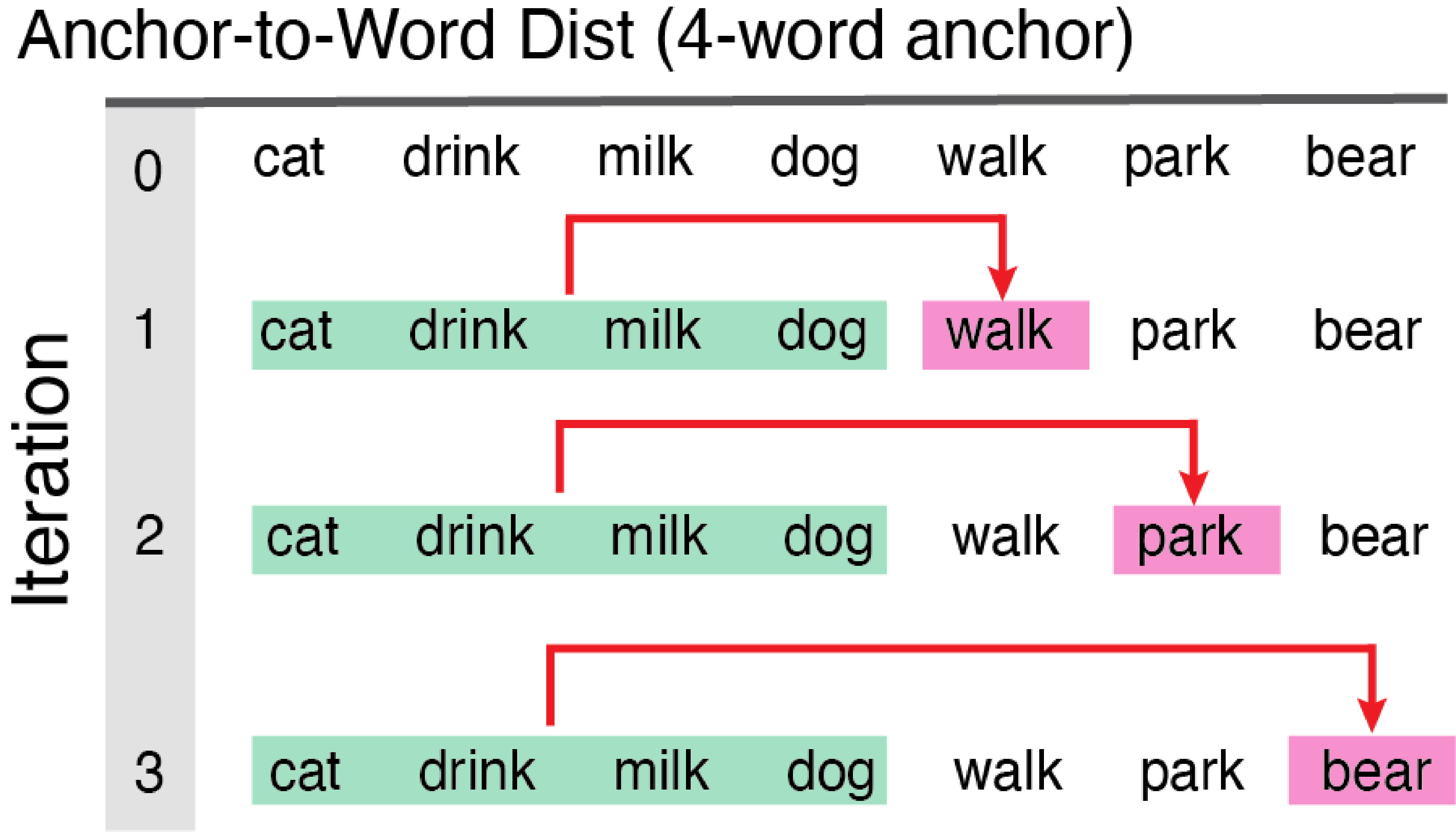
Anchored_Dists1 <- dist_anchor(dat=Monologue_Cleaned, anchor_size=8)
knitr::kable(head(Anchored_Dists1, 4), format = "pipe", digits = 2)| id_row_postsplit | word_clean | CosDist_Anchor_GLO | CosDist_Anchor_SD15 |
|---|---|---|---|
| 1 | NA | NA | NA |
| 2 | girl | 0.26 | 0.42 |
| 3 | walk | 0.16 | 0.19 |
| 4 | down | 0.12 | 0.27 |
dist_dialogueThis function works on dialogue transcripts only!!! Averages semantic
vectors for all content words in each speaker’s turn then computes the
cosine distance to the average of the semantic vectors of the content
words in the subsequent turn.
Arguments to
dist_dialogue:
-dat dataframe w/ a
dialogue sample cleaned and prepped using clean_dialogue.
-who_talking quoted argument specifying 2-level factor
variable name for person producing given text.
DialogueDists <- dist_dialogue(dat=Dialogue_Cleaned, who_talking='speaker')
knitr::kable(head(DialogueDists, 4), format = "pipe", digits = 2)| turn_count | speaker | n_words | glo_cosdist | sd15_cosdist |
|---|---|---|---|---|
| 1 | Mary | 3 | 0.83 | 0.58 |
| 2 | Peter | 4 | 0.85 | 0.58 |
| 3 | Mary | 1 | 0.86 | 0.58 |
| 4 | Peter | 3 | 0.86 | 0.45 |
dist_paired_colsThis function works on word pairs in columns only!!! Output of
dist_paired_cols on 2-column arrayed dataframe.
Arguments to
dist_paired_cols
-dat dataframe w/
word pairs arrayed in columns cleaned and prepped.
Columns_Dists <- dist_paired_cols(WordPairs_Clean) #only argument is dataframe
knitr::kable(head(Columns_Dists, 6), format = "pipe", digits = 2)| id_row_orig | word1_clean | word2_clean | word1 | word2 | CosDist_SD15 | CosDist_GLO |
|---|---|---|---|---|---|---|
| 1 | dog | trumpet | Dog | trumpet | 0.45 | 0.84 |
| 2 | the | banana | the | BANANA | 1.18 | 0.77 |
| 3 | rat | astronaut | rat | astronaut | 1.22 | 0.93 |
| 5 | bird | bird | bird | bird | 0.00 | 0.00 |
| 6 | shark | shark | shark | shark | 0.00 | 0.00 |
| 8 | dog | leash | Dog | leash | 0.68 | 0.50 |
Choose your visualization option based on the nature of your data. An
temporally ordered text such as a story can be plotted like a time
series. This would not make sense for Unordered lists (bags-of-words).
However, with word lists you might be interested in using scaling
procedures to find latent structure or similarities.
SemanticDistance has two options for computing clustering
and network properties for a vector of words, i.e., hierarchical
clustering and simple network visualization. The function also returns a
square matrix with all pairwise semantic distance values for a word
list.
wordlist_to_networkProduces a dendogram from a vector of words. First pulls words, then
creates a square matrix with cosine distances for all possible word
pairs: d[i,j]. Then converts semantic distance matrix to Euclidean
distance. Then plots a hierchcial clustering solution moving words
closer together in proximity based on their distance. Works best for
unordered word lists.
Arguments to
wordlist_to_network:
-dat dataframe
processed using clean_monologue_or_list()
-output quoted argument dendrogram or
network default is dendrogram.
-dist_type quoted argument, which distance norms would you
like? default is embedding alternative is
SD15.
MyCleanList <- clean_monologue_or_list(dat=Unordered_List, wordcol='mytext')
mydendro <- wordlist_to_network(MyCleanList, output='dendrogram', dist_type='embedding')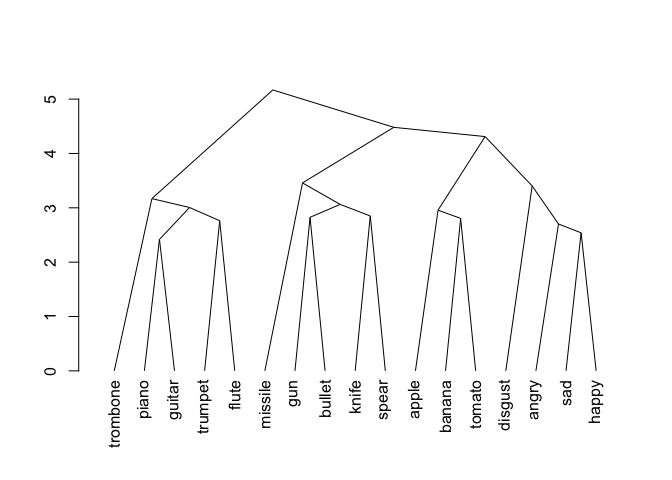
print(mydendro)
#> 'dendrogram' with 2 branches and 17 members total, at height 5.168642clean_monologue_or_listProduces a dendogram from a vector of words. First pulls words, then
creates a square matrix with cosine distances for all possible word
pairs: d[i,j]. Then converts semantic distance matrix to Euclidean
distance. Then plots a hierchcial clustering solution moving words
closer together in proximity based on their distance. Works best for
unordred word lists cleaned with clean_monologues().
Arguments to
clean_monologue_or_list
-
datinput formatted dataframe. <br> -dist_typequoted argument distance option, default is "embedding", alt isSD15`.
MyCleanList <- clean_monologue_or_list(dat=Unordered_List, wordcol='mytext')
mynetwork <- wordlist_to_network(MyCleanList, output='network', dist_type='embedding')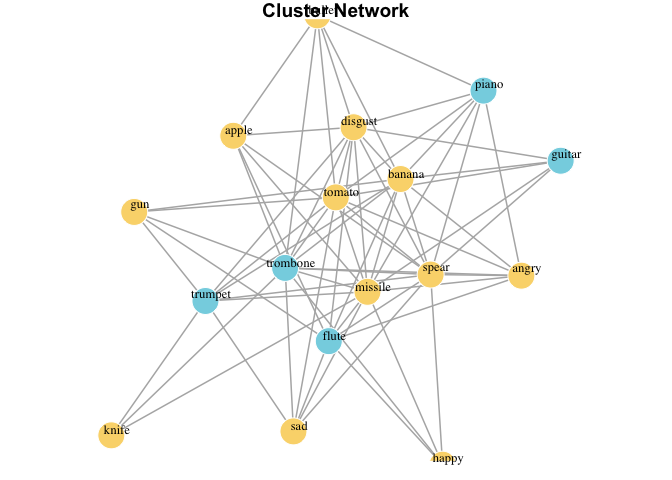
print(mynetwork)
#> IGRAPH a2ffa13 UNW- 17 68 --
#> + attr: name (v/c), cluster (v/n), color (v/c), size (v/n), label
#> | (v/c), label.color (v/c), label.cex (v/n), weight (e/n), color (e/c),
#> | width (e/n)
#> + edges from a2ffa13 (vertex names):
#> [1] trombone--missile trombone--gun trombone--bullet trombone--knife
#> [5] trombone--spear trombone--apple trombone--banana trombone--tomato
#> [9] trombone--disgust trombone--angry trombone--sad trombone--happy
#> [13] piano --missile piano --bullet piano --spear piano --banana
#> [17] piano --tomato piano --disgust piano --angry guitar --missile
#> [21] guitar --spear guitar --banana guitar --tomato guitar --disgust
#> + ... omitted several edgesFor bugs, feature requests, and general questions, reach out via one
of the following options:
1. Report
Bugs
2. View
Discussions
3. Read
News and Release Notes.
If none of these options do the trick, please email the package maintainer, Jamie Reilly for assistance.
These binaries (installable software) and packages are in development.
They may not be fully stable and should be used with caution. We make no claims about them.